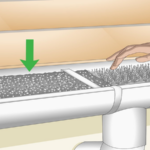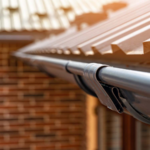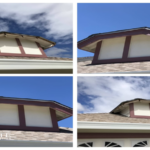Gutters are one of the most important components of your home’s exterior, and proper installation is crucial to their function. While you may be tempted to save money by installing them yourself, it’s best to leave this job to the professionals. Here’s what you need to know about quality gutter installation.
Gutters are designed to protect your home from water damage by channeling water away from the foundation. They should be installed with a slight slope, so that water can flow freely through the system. If your gutters are not installed properly, water can pool in them and cause damage to your home’s foundation or siding.
There are two types of gutters: sectional and seamless. Sectional gutters are made in sections and installed with brackets, while seamless gutters are made from a single piece of material and installed with hangers. Seamless gutters are less likely to leak, but they are more expensive.
Gutter installation should be done by a professional who has experience with the type of gutters you’ve chosen. They will know how to properly install the gutters and ensure that they are functioning properly.
If you live in an area with a lot of trees, you may need to have your gutters cleaned more often than homes in other areas. Leaves and debris can clog gutters and cause them to overflow, which can lead to water damage.
What do I need to know about installing gutters?
There are a few things you need to take into account when installing gutters, such as the size and type of your home, the climate you live in, and your budget. The most important thing to remember is that gutters are designed to protect your home from water damage by channeling water away from your roof and foundation.
If you live in an area with a lot of rainfall, you’ll want to make sure your gutters are able to handle the volume of water. You’ll also want to take into account the type of roof you have, as some roofs are more susceptible to leaking than others. If you’re not sure what size or type of gutter system is best for your home, you can always consult with a professional.
As for the budget, gutters can range in price from a few hundred dollars to a few thousand, depending on the size and type of system you choose. If you’re handy, you may be able to save money by installing the gutters yourself. However, if you’re not confident in your ability to do so, it’s always best to hire a professional.
What is the rule of thumb for downspouts?
There are a few general rules of thumb for downspouts. One is that they should be at least eight feet long in order to ensure that water is directed far enough away from the foundation of your home. Another rule of thumb is that downspouts should be installed on all four sides of your home if possible, in order to ensure that water is directed away from the foundation on all sides. Additionally, it is generally advisable to have one downspout for every 30 to 50 feet of gutter, in order to ensure that the gutters are not overloaded and that water is directed away from the home as efficiently as possible.
Should gutters go under drip edge?
There is no definitive answer to this question since there are pros and cons to both installation methods. Some installers prefer to install gutters under the drip edge because they feel it provides a cleaner look and prevents leaves and debris from accumulating in the gutter. However, others believe that installing gutters over the drip edge is a better method because it allows water to more easily flow into the gutter and prevents the gutters from being damaged by the weight of the roof shingles. Ultimately, it is up to the homeowner to decide which installation method they prefer.
Should there be a gap between roof and gutter?
There are three schools of thought when it comes to the question of whether or not there should be a gap between a roof and gutter. The first school of thought is that a gap is necessary in order to allow for proper drainage and prevent water damage. The second school of thought is that a gap is not necessary and can actually lead to water damage. The third school of thought is that it depends on the specific circumstances of the home. Each of these schools of thought has valid points that should be considered when making a decision about whether or not to have a gap between a roof and gutter.
The first school of thought, that a gap is necessary in order to allow for proper drainage and prevent water damage, is based on the fact that water will always follow the path of least resistance. If there is a gap between the roof and the gutter, the water will flow into the gap and be diverted away from the home, preventing water damage. This is the most common reason why people choose to have a gap between their roof and gutter.
What is better vinyl or aluminum gutters?
There is no definitive answer to this question as it depends on a number of factors. Some people prefer vinyl gutters because they are less expensive and easier to install than aluminum gutters. However, aluminum gutters are more durable and require less maintenance than vinyl gutters. Ultimately, the decision of which type of gutter to install depends on the specific needs and preferences of the homeowner.
Can I install gutters myself?
Installing gutters is a job that many homeowners are capable of doing themselves. However, there are a few things to consider before taking on this project. The first is whether or not your home is suitable for a do-it-yourself gutter installation. If it is a two-story home or higher, it is probably best to leave the job to the professionals. The second thing to consider is whether you feel comfortable working on a ladder. If not, installing gutters may not be the project for you.
Assuming your home is a good candidate for a do-it-yourself gutter installation and you are comfortable working on a ladder, the process is relatively straightforward. The first step is to gather the necessary materials, which include gutters, hangers, downspouts, and any other necessary hardware. Once you have all of the materials, you will need to measure the length of the gutters you will need and cut them to size. The next step is to install the hangers, which will support the gutters. Once the hangers are in place, you can then attach the gutters to the hangers. Finally, you will need to install the downspouts, which will channel the water away from your home.
How hard is it to install gutters yourself?
Installing gutters yourself is not as difficult as one might think. The most difficult part is likely getting up on the ladder and ensuring that the gutters are level as you install them. Other than that, the process is fairly straightforward. You will need to measure the length of your home’s eaves and then cut the gutters to size. Once you have the gutters cut, you will need to install the hangers which will support the gutters. After that, it is simply a matter of sliding the gutters into place and attaching them to the hangers.
How far apart should gutter brackets be spaced?
There is no definitive answer to this question as it will depend on a number of factors, such as the size and type of gutter, the amount of rainfall in your area, and the angle of your roof. However, as a general rule of thumb, most experts recommend spacing gutter brackets between 24 and 32 inches apart.
Final Talk
If you’re thinking about having new gutters installed, or if you’re considering doing it yourself, there are a few things you need to know. First, make sure you choose a high-quality product. There are a lot of options out there, and it can be tempting to go with the cheapest option, but it’s worth it to spend a little extra for a product that will last. Second, make sure you hire a professional to do the installation. It may seem like a simple job, but if it’s not done correctly it can cause a lot of problems. A professional will know how to properly install your gutters so that they function properly and look great. Finally, be sure to maintain your gutters on a regular basis. This means cleaning them out regularly and making sure there are no cracks or leaks. By following these tips, you can be sure that your gutters will last for years to come.















